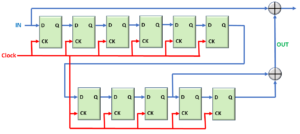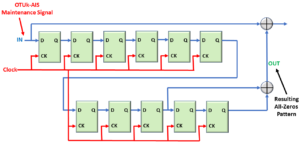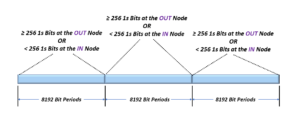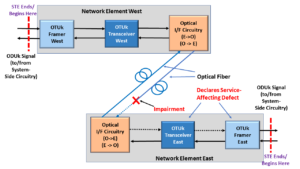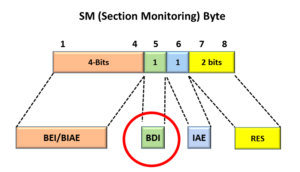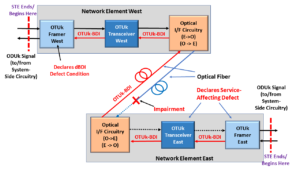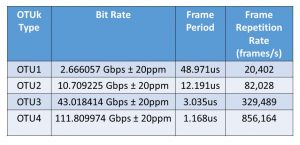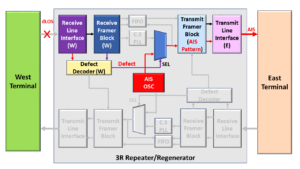What is the OTSi/OTUk_A_Sk Atomic Function?
The expression: OTSi/OTUk_A_Sk is an abbreviation for the term: Optical Tributary Signal to OTUk Adaptation Sink Function.
This blog post will briefly describe the OTSi/OTUk_A_Sk set of atomic functions.
We discuss the OTSi/OTUk_A_Sk Atomic Function in detail in Lesson 9, within THE BEST DARN OTN TRAINING PRESENTATION…PERIOD!!!
Changes in Terminology
Before we proceed on with this post, we need to cover some recent changes in terminology. Before the June 2016 Version of ITU-T G.709, the standard documents referred to this particular atomic function as the OCh/OTUk_A_Sk function.
However, the standards committee has recently decided to change the wording from using the term OCh (for Optical Channel) to OTSi (for Optical Tributary Signal).
For completeness, I will tell you that ITU-T G.959.1 defines the term OTSi as:
“Optical signal that is placed within a network media channel for transport across the optical network. This may consist of a single modulated optical carrier or a group of modulated optical carriers or subcarriers”.
Hence, to “speak the same language” as the standard committee, we will call this atomic function the OTSi/OTUk_A_Sk atomic function.
Likewise, in another post, we will now call (what we used to call the OCh/OTUk_A_So function) the OTSi/OTUk_A_So function.
I have created another post that provides documentation of the relationships between some old (now obsolete) terms and the new (and approved) ones that our standard committee is currently using.
The OTSi/OTUk_A_Sk Function
The OTSi/OTUk_A_Sk function is any circuit that takes an OTSi electrical signal and converts this data back into the OTUk signal.
More specifically, the System-Designer will apply an OTSi signal (which will be a fully-framed and scrambled OTUk electrical signal that often includes Forward-Error-Correction) to the OTSi_AP input interface.
This function will convert this signal into OTUk data, clock, frame start, and multi-frame start signals.
This function will also decode the Forward-Error-Correction field (if available) and output these signals to downstream circuitry (such as the OTUk_TT_Sk function).
ITU-T G.798 states that the system designer can use this function for all OTUk rates (e.g., from OTU1 through OTU4).
However, in most cases, we will typically use the OTSi/OTUk_A_Sk function for OTU1 and OTU2 applications. We will usually use the OTSiG/OTUk_A_Sk atomic function for OTU3 and OTU4 applications.
We discuss the OTSiG/OTUk_A_Sk atomic function in another post.
Figure 1 presents a simple illustration of the OTSi/OTUk_A_Sk function.

Figure 1, Simple Illustration of the OTSi/OTUk_A_Sk function
ITU-T G.798 defines three versions of this particular function. I have listed these versions below in Table 1.
Table 1, List of the ITU-T G.798 -specified Versions for the OTSi/OTUk_A_Sk functions
| Function Name | Description | Comments |
| OTSi/OTUk-a_A_Sk | OTSi to OTUk Adaptation Sink Function with ITU-T G.709 Standard FEC | Can be used for OTU1 through OTU4 applications. |
| OTSi/OTUk-b_A_Sk | OTSi to OTUk Adaptation Sink Function with No FEC | Cannot be used for OTU4 applications |
| OTSi/OTUk-v_A_Sk | OTSi to OTUk Adaptation Sink Function with Vendor-Specific FEC | Can be used for OTU1 through OTU4 applications. |
Table 1 shows that the OTSi/OTUk-a_A_Sk and the OTSi/OTUk-v_A_Sk functions will compute and decode some sort of FEC field within the backend of each incoming OTUk frame.
However, this table also shows that the OTSi/OTUk-b_A_Sk version does not support FEC decoding.
Therefore, ITU-T G.798 states that one can use the OTSi/OTUk-a_A_Sk and OTSi/OTUk-v_A_Sk functions for OTU1 through OTU4 applications. Further, the standard recommends that the user NOT use the OTSi/OTUk-b_A_Sk function for OTU4 applications.
Network Terminals operating at the OTU4 rate are required to use Forward-Error-Correction.
Clueless about OTN? We Can Help!!! Click on the Banner Below to Learn More!!!
Corporate Discounts Available!!!

What Version (of the OTSi/OTUk_A_Sk function) will we Discuss Throughout this Post?
Throughout this post, we will be discussing the OTSi/OTUk-a_A_Sk version of this atomic function.
The OTSi/OTUk-b_A_Sk and OTSi/OTUk-v_A_Sk atomic functions do everything that the OTSi/OTUk-a_A_So does, except that the -b version does NO FEC Decoding and the -v version does FEC Decoding differently than what I describe here.
So What All Does this Atomic Function Do?
The OTSi/OTUk-a_A_Sk function will accept an OTSi data stream from the upstream Optical-to-Electrical Conversion circuitry. This function will perform the following tasks on this incoming data stream.
- Descrambling – It will descramble this incoming data stream.
- FEC Decoding – The function will decode the FEC field (within the backend of each incoming OTUk frame) and detect and correct most symbol errors within this data stream.
- Extract the Frame-Start and Multi-Frame Start signals from this incoming data stream.
- Detect and Flag the following service-affecting defect conditions
- Assert the CI_SSF (Server Signal Fail Indicator) output signal (towards the downstream OTUk_TT_Sk function) anytime it declares any service-affecting defect conditions.
- Output the remaining OTUk data stream, the OTUk clock signal, the Frame-Start, and Multi-Frame Start signals to downstream circuitry (e.g., typically the OTUk_TT_Sk atomic function).
Figure 2 illustrates a Unidirectional Connection where the OTSi/OTUk-a_A_Sk function “fits in” a system.

Figure 2, Illustration of an STE, transmitting an OTUk signal (over optical fiber) to another STE – the OTSi/OTUk-a_A_Sk function is highlighted.
Functional Description of this Atomic Function
Let’s now take a closer look at this function.
Figure 3 presents the Functional Block Diagram of the OTSi/OTUk-a_A_Sk Atomic Function.

Figure 3, Illustration of the Functional Block Diagram of the OTSi/OTUk-a_A_Sk Atomic Function
Therefore, Figure 3 shows that this function contains the following functional blocks
I will briefly discuss each of these functional blocks below.
The Clock Recovery and dLOS (Loss of Signal Defect) Detection Blocks
The Clock Recovery block is responsible for recovering the clock signal and data content within the incoming OTSi signal via the AI_PLD input pin.
To that end, I illustrate the OTSi/OTUk-a_A_Sk Functional Block Diagram with the Clock Recovery and dLOS Detection Blocks highlighted below in Figure 4.

Figure 4, Illustration of the OTSi/OTUk-a_A_Sk Functional Block Diagram, with the Clock Recovery and dLOS Detection Blocks highlighted.
Since the OTSi/OTUk-a_A_So atomic function (within the remote STE) should have scrambled this data stream, there should always be good timing content (or transitions) within the incoming OTSi signal so that this Clock Recovery block can acquire and extract out both a recovered clock signal and data-stream.
Suppose the Clock Recovery and dLOS Detection blocks determine a lengthy absence in signal transitions (within the incoming OTSi data-stream). It will declare the dLOS-P (Loss of Signal-Path) defect condition in that case.
Please check out the dLOS blog post for more information about the dLOS-P defect condition.
The OTSi/OTUk-a_A_Sk function will route this recovered clock and data signal to the dAIS Detector and Frame Alignment blocks for further processing.
Stuck at Home? You Can Be an Expert on OTN Before You Return to Your Office!!! Click on the Banner Below to Learn More!!!
Discounts Available for a Short Time!!!

The dAIS (Alarm Indication State Defect) Detector Block
As the newly recovered clock and data signal travel to the Frame Alignment block, the dAIS Detector block will also parse through this data stream to see if it should declare or clear the dAIS (Alarm Indication Signal Defect) condition or not.
To make things more convenient, I present an illustration of the OTSi/OTUk-a_A_Sk Functional Block Diagram, with the AIS Detector block highlighted below in Figure 5.

Figure 5, Illustration of the OTSi/OTUk-a_A_Sk Functional Block Diagram, with the AIS Detector block highlighted.
In this case, the dAIS Detector block will check to see if the incoming data stream matches an OTUk-AIS maintenance signal.
ITU-T G.709 further states that the OTUk-AIS maintenance signal is an unframed PN-11 repeating pattern.
The standard defines the PN-11 sequence by the generating polynomial of 1 + x9 + x11.
Please see the blog post on the OTUk-AIS Maintenance signal for more information about this type of signal.
Additionally, please see the dAIS post for more information on how the AIS Detection circuit declares and clears the dAIS defect condition.
The Frame Alignment and dLOF (Loss of Frame Defect) Detection Blocks
As long as the dAIS Detector block is NOT declaring the dAIS defect condition, then the Frame Alignment block will process the incoming recovered block and data stream.
To make things more convenient for you, I present an illustration of the OTSi/OTUk-a_A_Sk Functional Block Diagram. This block diagram highlights the Frame Alignment and dLOF Detection below in Figure 6.

Figure 6, Illustration of the OTSi/OTUk-a_A_Sk Functional Block Diagram with the Frame Alignment and dLOF Detection circuitry highlighted.
The incoming recovered data stream should be a full, scrambled OTUk frame. However, the FAS field (e.g., the three OA1 and OA2 byte fields) should NOT be scrambled.
The Frame Alignment block will parse through the FAS fields within the incoming OTUk data stream. This block and the dLOF (Loss of Frame) Detection Block will declare and clear the dLOF defect as appropriate.
Please see the blog post on the dLOF defect for more information about how the Frame Alignment and dLOF Detection blocks declare and clear the dLOF defect condition.
Descrambler Block
In the OTSi/OTUk-a_A_So blog post, we mentioned that the OTSi/OTUk-a_A_So function would scramble the content of each OTUk frame.
That function will scramble all bytes (within each OTUk frame) except for the FAS fields. This function will even scramble the MFAS field as well.
The purpose of the Descrambler block is to restore the content of each OTUk frame to its original state before being scrambled at the remote STE.
To that end, I illustrate the OTSi/OTUk-a_A_Sk Functional Block Diagram with the Descrambler block highlighted below in Figure 7.

Figure 7, Illustration of the OTSi/OTUk-a_A_Sk Functional Block Diagram, with the Descrambler block highlighted.
In the OTSi/OTUk-a_A_So function, we scrambled the contents of each OTUk frame, using the polynomial generating equation of 1 + x + x3 + x12 + x16.
Therefore, the Descrambler block (within this function) will descramble the incoming OTUk data-stream (again) using the polynomial generating equation of 1 + x + x3 + x12 + x16.
I show a simple diagram of how one can implement the Descrambler within their OTSi/OTUk-a_A_Sk function design below in Figure 8.

Figure 8, High-Level Block Diagram of the Frame Synchronous Descrambler
I discuss the Descrambler function and requirements in greater detail in another post.
Next, the OTUk signal will proceed to the FEC Decoder block for further processing.
FEC (Forward-Error-Correction) Decoder Block
The OTSi/OTUk-a_A_So function (at the remote STE) is responsible for performing FEC (Forward Error Correction) Encoding.
This means that this function computed a FEC Code and inserted that code into a 4-row x 128-byte column field at the backend of each OTUk frame, as shown below in Figure 9.
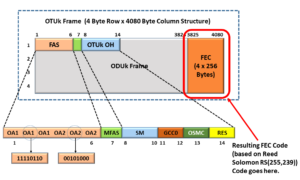
Figure 9, Illustration of the OTUk Frame Format with the FEC Field Highlighted
The purpose of the FEC Decoder (within the OTSi/OTUk-a_A_Sk function) is to parse through the incoming OTUk data stream and (by using the contents of the FEC-field) detect and correct most symbols errors within this data stream.
The FEC Decoder block will tally any occurrences of Symbol errors (within the incoming OTUk data stream). It will report this information to System Management via the MI_pFECcorrErr output (via the OTSi/OTUk-a_A_Sk_MP Interface).
I discuss this Forward-Error-Correction scheme in much greater detail in another post.
Multi-Frame Alignment and dLOM (Loss of Multi-Frame Defect) Detection Blocks
Once the incoming OTUk data stream passes through the FEC Decoder block, the OTSi/OTUk-a_A_Sk function will route this signal to the Multi-Frame Alignment and dLOM Detection blocks.
The Multi-Frame Alignment block will parse through and check the contents of the MFAS field within the incoming OTUk data stream. The Multi-Frame Alignment block will check the contents of this data stream to see if it (and the dLOM Detection Block) should declare or clear the dLOM defect condition.
Please see the blog post on the dLOM Defect for more information on how the Multi-Frame Alignment block will declare and clear the dLOM defect condition.
Removal of the FAS, MFAS, and FEC Fields from the incoming OTUk Data-stream
The Frame-Alignment block will drive the CI_FS (Frame-Start) output of the OTUk_CP Interface, HIGH for one CI_CK (Clock Signal) period, each time it detects the FAS field within its incoming OTUk data-stream.
Likewise, the Multi-Frame Alignment block will drive the CI_MFS (Multi-Frame Start) output of the OTUk_CP Interface, HIGH, for one CI_CK (Clock Signal) period each time it receives an MFAS byte with the value of 0x00.
The Frame-Alignment and Multi-Frame Alignment block will also remove the FAS and MFAS fields from the OTUk data stream (before it outputs this data stream via the CI_D output of the OTUk_CP Interface).
From this point on, the CI_FS and CI_MFS signals will now carry the framing and multi-framing alignment information downstream toward the OTUk_TT_Sk atomic function.
The FEC Decoder block will also remove the contents of the FEC field from the OTUk data stream before it outputs this data via the CI_D output pin.
Consequent Actions Block
In most cases, the Consequent Actions block will consist of digital logic circuitry that will assert the CI_SSF (Server Signal Fail) Output (of the OTUk_CP Interface) anytime the OTSi/OTUk-a_A_Sk function declares any of the following defect conditions.
Consequent Equation
ITU-T G.798 has the following Consequent Equation for the OTSi/OTUk_A_Sk function.
aSSF ⇐ dLOS-P or dAIS or dLOF or AI_TSF-P or dLOM
This Consequent Equation states that the OTSi/OTUk_A_Sk function MUST set aSSF to “1” (or drive the CI_SSF output pin to HIGH) if any of the following conditions are true:
- The OTSi/OTUk_A_Sk function declares any of the following defect conditions.
- Or, if the upstream Optical Circuitry drives the AI_TSF (Trail Signal Fail) input pin HIGH.
NOTE: Whenever this function asserts the CI_SSF output signal, it also asserts the CI_SSF input to the downstream OTUk_TT_Sk function.
Defect Correlation
If you wish to learn more about Defect Correlation and how you should interpret it, please see the Defect Correlation Post.
ITU-T G.798 specifies the following correlation equations for each OTSi/OTUk-a_A_Sk function-related defect.
- cLOS-P ⇐ dLOS-P and (NOT AI_TSF-P)
- cLOF ⇐ dLOF and (NOT dLOS-P) and (NOT dAIS) and (NOT AI_TSF-P)
- cLOM ⇐ dLOM and (NOT dLOS-P) and (NOT dLOF) and (NOT dAIS) and (NOT AI_TSF-P)
I will briefly explain what each of these equations means below.
cLOS-P ⇐ dLOS-P and (NOT AI_TSF-P)
This equation means that the OTSi/OTUk-a_A_Sk function will ONLY declare the dLOS defect (and assert the cLOS-P output pin) if:
- The Clock Recovery and LOS Detection circuitry is declaring the dLOS-P defect condition, and
- The upstream circuitry is NOT asserting the AI_TSF-P input of this function.
In other words, the OTSi/OTUk-a_A_Sk function should only declare the dLOS defect (and assert the cLOS-P output pin) if it is internally declaring the dLOS-P defect condition.
cLOF ⇐ dLOF and (NOT dLOS-P) and (NOT dAIS) and (NOT AI_TSF-P)
This equation means that the OTSi/OTUk-a_A_Sk function will ONLY declare the dLOF defect (and assert the cLOF output pin) if:
- The Frame Alignment and dLOF Detection circuitry declare the dLOF defect condition, and
- The Optical upstream circuitry is NOT asserting the AI_TSF-P input of this function, and
- The Clock Recovery and dLOS Detection circuitry is NOT currently declaring the dLOS-P defect condition, and
- The dAIS Detection circuitry is NOT also declaring the dAIS defect condition.
In other words, the OTSi/OTUk-a_A_Sk function should only declare the dLOF defect (and assert the cLOF output pin) if it internally declares the dLOF defect condition.
cLOM ⇐ dLOM and (NOT dLOS-P) and (NOT dAIS) and (NOT dLOF) and (NOT AI_TSF-P)
This equation means that the OTSi/OTUk-a_A_Sk function will ONLY declare the dLOM defect (and assert the cLOM output pin) if:
- The Multi-Frame Alignment and dLOM Detection circuitry declare the dLOM defect condition, and
- The Optical upstream circuitry is NOT asserting the AI_TSF-P input of this function, and
- The Clock Recovery and dLOS Circuitry is NOT currently declaring the dLOS-P defect condition, and
- The dAIS Detection circuitry is NOT also declaring the dAIS defect condition,
- The Frame Alignment and dLOF Detection circuitry are not currently declaring the dLOF defect condition.
Performance Monitoring
ITU-T G.798 requires that the OTSi/OTUk-a_A_Sk or OTSi/OTUk-v_A_Sk Functions tally and report the following Performance Monitoring parameter to System Management:
pFECcorrErr ⇐ ∑nFECcorrErr
In other words, the OTSi/OTUk-a_A_Sk or OTSi/OTUk-v_A_Sk functions are expected to tally and report each instant that the FEC Decoder block corrects an errored symbol within the incoming OTUk data stream.
Pin Description
I list the Input/Output Pin Description for the OTSi/OTUk-a_A_Sk Atomic Function below in Table 2.
Table 2, Pin Description for the OTSi/OTUk-a_A_Sk Atomic Function
| Signal Name | Type | Description |
| OTSi_AP Interface | | |
| AI_PLD | Input | OTUk Adaptation Information - OTUk Payload Input:
The user is expected to apply a fully-framed and scrambled OTUk signal (with FEC) to this input port.
NOTE: In most cases, this data will be received data that has just been converted back into the electrical format (from the optical format).
The OTSi/OTUk-a_A_Sk function will accept and descramble this data and extract out all of the following data from this signal.
- FEC - It will decode the FEC and it will correct most symbol errors that this function detects within this incoming data stream.
- FAS - The Framing Alignment Signal. The Framing Alignment signal information will be output via the CI_FS output of this function.
- MFAS - The Multiframe Alignment Signal. The Multiframe Alignment signal information will be output via the CI_MFS output of this function.
- OTUk Data - The content of the rest of the unscrambled OTUk data-stream. This remaining OTUk data-stream will be output via the CI_D output of this function.
- OTUk Clock signal. The resulting OTUk clock signal will be output via the CI_CK output of this function. |
| AI_TSF-P | Input | Adapted Information - Trail Signal Fail - Path:
This signal indicates whether the upstream circuitry is declaring a service-affecting defect condition (within the signal path) with the data that is being applied to the AI_PLD input. This signal has (essentially) the same meaning as AIS.
If this signal is TRUE, then the OTSi/OTUk-a_A_Sk function will automatically set the CI_SSF output TRUE. |
| AI_TSF-O | Input | Adapted Information - Trail Signal Fail - Overhead:
This signal indicates whether upstream circuitry is declaring a service-affecting defect condition within the signal overhead.
NOTE: This signal does not reflect the health of the signal-path. |
| OTUk_CP Interface | | |
| CI_D | Output | OTUk Characteristic Information - Data Output:
The OTSi/OTUk-a_A_Sk function will output the OTUk data-stream via this output pin. This OTUk data-stream will be unscrambled and it will contain all of the following portions of the OTUk frame.
- OTUk SMOH (Section Monitoring Overhead) data
- All remaining OTUk payload data (e.g., the ODUk/OPUk data).
This data will not include the FAS, MFAS nor FEC fields.
Data that is output via this signal, will be aligned with one of the edges of the CI_CK clock output signal. The system designer will typically route this signal to the CI_D input to the downstream OTUk_TT_Sk function. |
| CI_CK | Output | OTUk Characteristic Information - Clock Output:
As the OTUk_CP interface outputs data via the CI_D, CI_FS, CI_MFS and CI_SSF outputs; all of this data will be updated on one of the clock-edges of this clock output signal. |
| CI_FS | Output | OTUk Characteristic Information - Frame Start Output:
The OTUk_CP Interface will pulse this output signal HIGH (for one CI_CK clock period) whenever the OTUk_CP interface outputs the very first bit (or byte) of a new OTUk frame, via this CI_D output.
This output signal will pulse HIGH once for each OTUk frame. |
| CI_MFS | Output | OTUk Characteristic Information - Multiframe Start Output:
The OTUk_CP Interface will pulse this output signal HIGH (for one CI_CK period) whenever the OTUk_CP Interface outputs the very first bit (or byte) or a new OTUk multi-frame via the CI_D output.
This output signal will pulse HIGH once for each OTUk Multi-frame (or one for every 256 OTUk frames). |
| CI_SSF | Output | OTUk Characteristic Information - Server Signal Failure Output:
The OTUk_CP Interface will assert this signal anytime the OTSi/OTUk-a_A_Sk function is declaring a service-affecting defect with the data that it is receiving via the AI_D input).
The OTUk_CP Interface will assert this output signal, whenever the OTSi/OTUk-a_A_Sk function is declaring any of the following defects.
- dLOF
- dLOM
- dAIS
- AI_TSF (if the upstream circuitry is driving the AI_TSF-P input pin, to this function, HIGH). |
OTSi/OTUk-a_A_Sk_MP
Interface | | |
| MI_FECEn | Input | Management Interface - OTSi/OTUk-a_A_Sk FEC Decoding Enable/Disable Input:
This input pin permits the function user to either enable or disable FEC Decoding within the OTSi/OTUk-a_A_Sk function.
Setting this input HIGH enables FEC Decoding.
Setting this input LOW disables FEC Decoding.
If the FEC Decoder is enabled, then it will use the FEC field to correct most symbol errors within the incoming OTUk data-stream (via the AI_PLD input). |
| MI_pFECcorrErr | Output | Management Interface - FEC Corrected Symbol Count Output:
This output port reflects the number of symbol errors that the OTSi/OTUk-a_A_Sk function has corrected via the FEC Decoder.
This is a Performance Monitoring feature within the OTSi/OTUk-a_A_Sk function.
NOTE: This output pin is INACTIVE if the MI_FECEn input pin is set low (to disable the FEC Decoder). |
| MI_cLOM | Output | Management Interface - Loss of Multiframe (Correlated) Output Indicator:
This output pin indicates if the OTSi/OTUk-a_A_Sk function is currently declaring the dLOM defect.
If this input pin is LOW, then it indicates that the function is NOT currently declaring the dLOM defect condition.
Conversely, if this input pin is HIGH, then it indicates that the function is currently declaring the dLOM defect condition.
Please see the dLOM defect post for more information on this topic. |
| MI_cLOF | Output | Management Interface - Loss of Frame (Correlated) Output Indicator:
This output pin indicates if the OTSi/OTUk-a_A_Sk function is currently declaring the dLOF defect.
If this output pin is LOW, then it indicates that the function is NOT currently declaring the dLOF defect condition.
Conversely, if this output pin is HIGH, then it indicates that the function is currently declaring the dLOF defect condition.
Please see the blog post on the dLOF defect for more information on this topic. |
| MI_cLOS | Output | Management Interface - Loss of Signal (Correlated) Output Indicator:
This output pin indicates if the OTSi/OTUk-a_A_Sk function is currently declaring the dLOS defect.
If this output pin is LOW, then it indicates that the function is NOT currently declaring the dLOS defect.
Conversely, if this output pin is HIGH, then it indicates that the function is currently declaring the dLOS defect condition.
Please see the blog post on the dLOS defect, for more information about this topic. |
Has Inflation got You Down? Our Price Discounts Can Help You Fight Inflation and Help You Become An Expert on OTN!! Click on the Banner Below to Learn More!!
Discounts Available for a Short Time!!

Other OTN-Related Posts
Click on the Image below to see more OTN-Related Posts in this blog.

OTN Related Topics within this Blog General Topics Consequent Equations - What are they and How can you use them? ...


